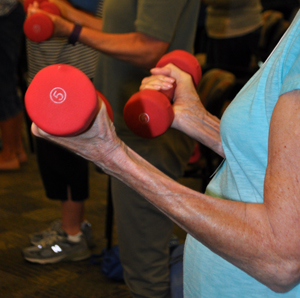Keeping Warm (and Healthy) In Winter
Return to Heath and Nutrition Agent Articles
With wintry winds, frigid temps and dark skies creeping in earlier and earlier, it’s no wonder most folks choose to stay inside and do little more than watch TV and munch on snack foods. But there are healthier — and warmer — ways to cope with the cold. One way is to exercise! For some, exercise inspires groans. But consider this: physical activity is anything that gets your body moving. It doesn’t have to be expensive or added on to your “to-do” list. Just move enough to get your heart rate up for at least 10 minutes at a time. That’s the type of activity that counts toward meeting the physical activity guidelines. Many household chores can count as physical activity.
For some, exercise inspires groans. But consider this: physical activity is anything that gets your body moving. It doesn’t have to be expensive or added on to your “to-do” list. Just move enough to get your heart rate up for at least 10 minutes at a time. That’s the type of activity that counts toward meeting the physical activity guidelines. Many household chores can count as physical activity.
Do you think you’re too “old” to exercise? Everyone can gain the health benefits of physical activity. If you are physically active, you have a lower risk of losing the ability to do everyday activities such as climbing stairs, grocery shopping, or playing with your grandchildren. As an older adult, regular physical activity is one of the most important things you can do for your health. It can prevent many of the health problems that seem to come with age. You don’t have to be in super physical shape or be active for long periods of time to reap the benefits of physical activity. Some is better than none! Health benefits will also increase with the more physical activity you do.
Soup made healthy — reduce the sodium
Eating hearty comfort foods is another way to stay warm during these colder months. Foods, like soups, pastas and stews are often hotter and heavier, which naturally warm people. But they’re also often loaded with simple carbohydrates, excess sodium and fatty ingredients.
A one-cup serving of a popular brand of lobster bisque has 380 calories, 27 grams of total fat, 16 grams of saturated fat, and 1,240 milligrams of sodium. New England clam chowder can contain up to 940 calories, 65 grams of total fat, and 34 grams of saturated fat per one-cup serving. It is better to choose tomato-based or broth-based soups, like vegetable or minestrone. Enjoy soup as an appetizer or with a salad or a whole-wheat roll. Choose low-sodium canned soup, because regular soup usually contains a lot of salt and preservatives.
The biggest worry of consuming too much salt and sodium is high blood pressure. High blood pressure is the leading cause of early death in women. It’s also a leading cause of early death for men, second only to smoking. Healthy blood pressure numbers are less than 120 for the top number, and less than 80 on the bottom.
One of the best ways to lower high blood pressure is to reduce the salt (or sodium) that you eat. That means doing more than putting away the salt shaker. About three-fourths of the sodium in the U.S. diet is from processed and restaurant foods.
The only way to know how much sodium is in a packaged food is to read the Nutrition Facts on the back label. Also, become aware of the terms that you may see on the front label. Below is the definition of what each claim means:
- Sodium Free – Less than 5 mg sodium per serving.
- Very low in sodium – No more than 35 mg sodium per serving.
- Low in sodium – No more than 140 mg sodium per serving.
- Unsalted – No salt was added during processing.
- Light in sodium – Half or less of the sodium in the original product.
- Reduced sodium – One-fourth or less of the sodium in the original product.
- Healthy – Less than 480 mg sodium for an individual food, or 600 mg sodium for a meal (such as a frozen dinner).
